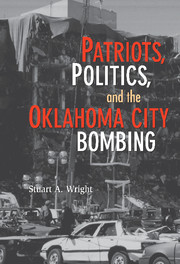Book contents
- Frontmatter
- Contents
- List of Figures and Tables
- Preface and Acknowledgments
- 1 CODICIL TO A PATRIOT PROFILE
- 2 PATRIOTS, POLITICAL PROCESS, AND SOCIAL MOVEMENTS
- 3 THE HISTORICAL CONTEXT OF PATRIOT INSURGENCY
- 4 THE FARM CRISIS, THREAT ATTRIBUTION, AND PATRIOT MOBILIZATION
- 5 STATE MOBILIZATION: BUILDING A TRAJECTORY OF CONTENTION
- 6 THE GUN RIGHTS NETWORK AND NASCENT PATRIOTS: RISE OF A THREAT SPIRAL
- 7 MOVEMENT-STATE ATTRIBUTIONS OF WAR: RUBY RIDGE AND WACO
- 8 PATRIOT INSURGENCY AND THE OKLAHOMA CITY BOMBING
- 9 AFTER OKLAHOMA CITY: PATRIOT DEMOBILIZATION AND DECLINE
- References
- Index
7 - MOVEMENT-STATE ATTRIBUTIONS OF WAR: RUBY RIDGE AND WACO
Published online by Cambridge University Press: 05 June 2012
- Frontmatter
- Contents
- List of Figures and Tables
- Preface and Acknowledgments
- 1 CODICIL TO A PATRIOT PROFILE
- 2 PATRIOTS, POLITICAL PROCESS, AND SOCIAL MOVEMENTS
- 3 THE HISTORICAL CONTEXT OF PATRIOT INSURGENCY
- 4 THE FARM CRISIS, THREAT ATTRIBUTION, AND PATRIOT MOBILIZATION
- 5 STATE MOBILIZATION: BUILDING A TRAJECTORY OF CONTENTION
- 6 THE GUN RIGHTS NETWORK AND NASCENT PATRIOTS: RISE OF A THREAT SPIRAL
- 7 MOVEMENT-STATE ATTRIBUTIONS OF WAR: RUBY RIDGE AND WACO
- 8 PATRIOT INSURGENCY AND THE OKLAHOMA CITY BOMBING
- 9 AFTER OKLAHOMA CITY: PATRIOT DEMOBILIZATION AND DECLINE
- References
- Index
Summary
Ruby Ridge and Waco have a special symbiotic relationship: They were both targets of weapons violations by state paramilitary units, erupted into deadly standoffs, encompassed many of the same state actors and agents, and were coupled in time. Indeed, Ruby Ridge and Waco were separated by only six months, a time during which the state's heightened campaign of gun control produced a torrent of federal gun raids by PPUs in the early 1990s. The twin tragedies of Ruby Ridge and Waco were the most egregious, lethal manifestations of the military model. War framing by the state produced inflated perceptions of threat posed by the Weavers and the Branch Davidians. In turn, the sieges at Ruby Ridge and Waco, both based on weapons violations, aroused the deepest fears of Patriot and gun rights groups, expressed laconically by NRA president Wayne LaPierre in 1994 as a “full-scale war to … eliminate private firearms ownership completely and forever” (quoted in Stern, 1996: 111). LaPierre's terse characterization was widely shared by those in the Patriot and gun rights networks as this attribution of war galvanized antigovernment sentiment and propelled the threat/opportunity spiral upward. A brief examination of these two federal sieges reveal a host of features that both the state and challenging groups mutually defined as “warfare” in a deadly escalation of conflict.
- Type
- Chapter
- Information
- Patriots, Politics, and the Oklahoma City Bombing , pp. 139 - 165Publisher: Cambridge University PressPrint publication year: 2007



